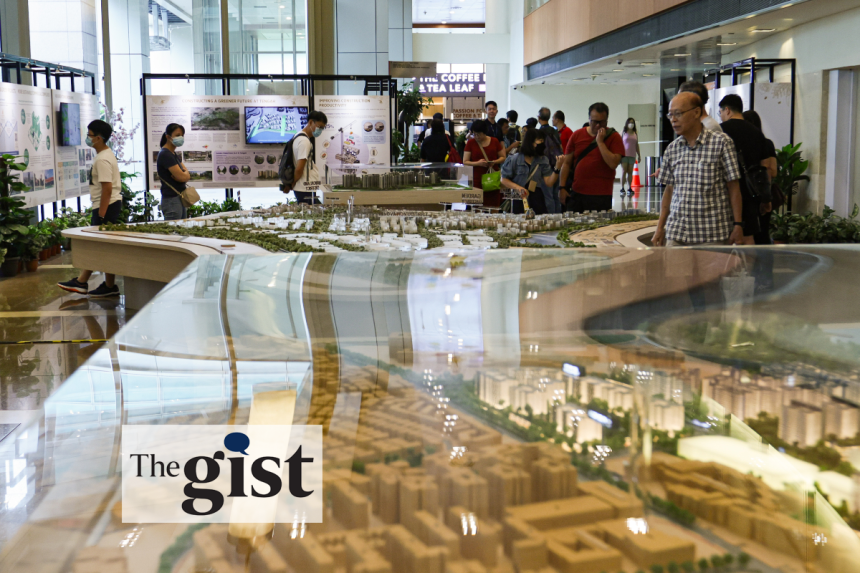SINGAPORE – A new classification for Housing Board flats. Another round of property cooling measures. New housing developments across the island. Here is a snapshot of five key housing stories this year:
1. New HDB classification
From the second half of 2024, Build-To-Order (BTO) flats in choicer locations will be launched under the Prime and Plus categories, which have extra subsidies applied to keep prices affordable.
These flats come with stricter resale conditions, including a 10-year minimum occupation period (MOP) and a subsidy clawback upon resale. Resale buyers of Prime and Plus flats will be subject to an income ceiling, which is currently $14,000 a month.
The new categories are:
- Prime: Flats located in the choicest locations close to the city centre. These flats receive the most subsidies, and the subsidy clawback has been typically set at 6 per cent. The latest two BTO projects in prime locations have an 8 per cent clawback.
- Plus: Located in attractive locations within each region across Singapore, such as near an MRT station or town centre. The subsidy clawback rate will be lower than for Prime flats due to the smaller subsidy amount.
- Standard: These flats come with a five-year MOP and have no income ceiling for buyers on resale. They will continue to form the bulk of the housing supply.
Why it matters:
The new model will replace HDB’s current framework of classifying estates as either mature or non-mature, which has been in place since 1992.
It will allow HDB to keep flats in more attractive locations affordable by providing more subsidies, and also curb the “lottery effect” of securing such flats by imposing stricter resale conditions. The income ceiling on resale buyers is meant to moderate resale flat prices, and help maintain a better social mix in the longer term.
The new Plus category, in addition to the current prime location public housing model which will be renamed Prime, should deter speculative buyers who view their flat as a short-term investment, property analysts said.
2. ABSD hike
In April, the Government raised the additional buyer’s stamp duty (ABSD) in response to rising property prices. It was the third round of cooling measures in 16 months.
The adjustments included raising the ABSD rate for foreigners buying any residential property from 30 per cent to 60 per cent.
Before the hike, private home prices in the first quarter of 2023 jumped 3.3 per cent, up sharply from 0.4 per cent in the last quarter of 2022. Prices also surged 11.4 per cent year on year, according to Urban Redevelopment Authority figures.
Why it matters:
The April cooling measures were aimed at preventing property prices from being pushed up by investors, and prioritising Singaporeans buying homes for owner-occupation.
Foreign buyers were hit the hardest, which led to fewer foreigners buying private properties in the months after the hike.
In January, foreign buyers accounted for 5 per cent of non-landed private resale home transactions, or 26 transactions. The proportion fell to 3.7 per cent in May, and by November it had slipped to 1.2 per cent, or nine transactions, according to real estate agency PropNex.
Property analysts said the aggressive ABSD hike for foreign buyers shows the Government wants to discourage speculative buying, especially those who buy a large number of units here.
3. Debate on housing affordability
In February, Parliament debated two motions on the affordability and accessibility of HDB flats for 12 hours over two days. One was filed by Progress Singapore Party Non-Constituency MP Leong Mun Wai, and the other by National Development Minister Desmond Lee.
Mr Leong proposed a housing scheme in which buyers would pay only the construction cost plus a notional location premium for their flats. They would pay the land cost, with accrued interest, only when they sell their flats in the resale market. His proposal drew criticism from political office-holders, who said it would erode the country’s reserves.
In response, Mr Lee outlined how the Government is tackling rising prices for new and resale HDB flats.
Parliament subsequently voted to pass Mr Lee’s motion, and rejected Mr Leong’s.
Why it matters:
The debate in Parliament came on the heels of concerns over the affordability of public housing. The Covid-19 pandemic had disrupted the supply of flats, and waiting times for new flats and resale prices went up.
The hot-button issue was robustly debated by the House, and Mr Lee gave a preview of policies that the Government would subsequently announce to address concerns.
In his Budget speech, Deputy Prime Minister and Finance Minister Lawrence Wong said housing grants for first-timer families and singles buying HDB resale flats would be increased.
During the debate on his ministry’s spending plans, Mr Lee announced a new First-Timer (Parents and Married Couples) priority category, which covers married couples aged 40 and below and those with Singaporean children aged 18 and below. More flats have been set aside for people in this group, who will also get one additional ballot chance in their flat applications.
First-timer applicants who do not select a BTO flat when invited to do so will be considered second-timers in subsequent flat applications for a year, Mr Lee added.

4. New housing developments in the works
Bayshore
About 7,000 HDB flats and 3,000 private homes will be built in Bayshore as an extension of Bedok town. The first two BTO projects, comprising about 1,400 two-room flexi, three-room and four-room flats, will be launched for sale in the second half of 2024.
The 60ha Bayshore estate, expected to be fully developed by the mid-2030s, sits on reclaimed land bounded by Upper East Coast Road and East Coast Parkway.
Pearl’s Hill
About 6,000 public and private homes will be built on Pearl’s Hill in Chinatown over the next decade. The car-lite district will have BTO and rental flats, condominiums and serviced apartments. A mixed-use development connected to Outram Park MRT station is also in the works.
These are part of efforts to provide a mix of housing options in central locations under the Draft Master Plan 2025, which sets out development and land-use plans for Singapore over the next 10 to 15 years.
Tanglin Halt
Up to 5,500 HDB flats will be built as part of redevelopment plans for Tanglin Halt, one of Singapore’s oldest housing estates within Queenstown.
A key feature of the rejuvenated estate will be an integrated development, which will have HDB flats, shops, and a hawker centre and market. It will be built in phases on the site of the former Tanglin Halt Neighbourhood Centre.
Some 250 two-room flexi and four-room flats forming part of the integrated development will be launched in February 2024.
Mount Pleasant

About 5,000 HDB flats across six BTO projects will be built in Mount Pleasant over the next decade, with the first project to be launched in 2025.
The 33ha estate, which is around one-third the size of Bidadari, sits close to Bukit Brown and the Central Catchment Nature Reserve. Heritage elements from the Old Police Academy and pre-war black-and-white bungalows, along with surrounding greenery, will be woven into the design of the new estate.
Why it matters:
The Government’s plans to develop these housing estates – some located on brownfield sites – in the coming years mean there will be a steady supply to meet the firm demand for public housing.
Demand for housing shot up during the Covid-19 pandemic, with the number of applications received per BTO flat rising from 2.6 in 2018 to 5.8 in 2020.
The difficulty in balloting for a flat, coupled with construction delays, could have led some home seekers to buy resale flats instead, which caused prices to surge, analysts noted.
With a stable housing supply in the pipeline, prices in the resale market could also be moderated in the long run.
5. Long Island
Waterfront homes, amenities and industrial facilities are expected to be built on the future Long Island, an 800ha plot of reclaimed land off East Coast Park running from Marina East to Tanah Merah.
The project, which will likely create Singapore’s 18th reservoir, is meant to reduce flood risks in the East Coast area. About 20km of new coastal and reservoir parks could also be added, trebling the length of waterfront parks in the East Coast area.
Over the next few years, the public will be consulted for their ideas and suggestions for the project, which will take several decades to plan, design and develop.
Why it matters:
Long Island is Singapore’s response to the threat of rising sea levels, and addresses the country’s future land needs at the same time.
This proposal is the latest move to create more land for development, along with other long-term plans like relocating the port to Tuas to form the Greater Southern Waterfront, and relocating Paya Lebar Air Base to Changi. There is currently no timeline for the development of Long Island.
While the reclamation project is not expected to have any impact on the housing market now, analysts noted that some homes in East Coast may lose their sea views in the future.
Even then, residents in the area could benefit from more recreational facilities, as well as quicker commutes to work if new offices are built on Long Island.


